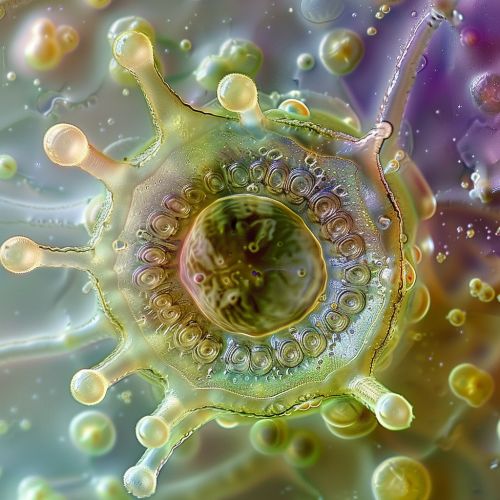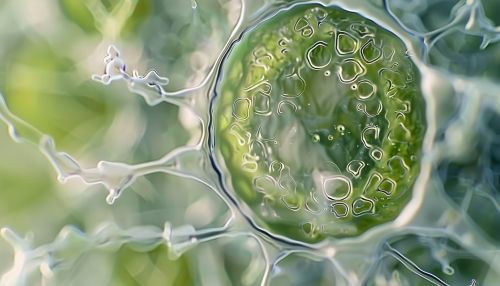Vacuoles
Introduction
A vacuole is a membrane-bound organelle found in the cells of plants, fungi, and certain protists, as well as in some animal and bacterial cells. The vacuole is a versatile and multifunctional component of the cell, playing a critical role in maintaining cellular homeostasis, storing nutrients and waste products, and contributing to cellular growth and development. This article delves deeply into the structure, function, and significance of vacuoles, providing a comprehensive overview suitable for expert-level understanding.
Structure of Vacuoles
Vacuoles are enclosed by a membrane known as the tonoplast, which separates the vacuole's contents from the cytoplasm. The tonoplast is selectively permeable, allowing the transport of ions, nutrients, and waste products in and out of the vacuole. The interior of the vacuole, called the vacuolar lumen, contains a solution of water, enzymes, ions, and other molecules.
Types of Vacuoles
There are several types of vacuoles, each with distinct functions:
- **Central Vacuole**: Predominantly found in plant cells, the central vacuole can occupy up to 90% of the cell's volume. It is crucial for maintaining turgor pressure, which is essential for plant rigidity and growth.
- **Contractile Vacuole**: Found in certain protists, such as Paramecium, contractile vacuoles expel excess water from the cell, helping to regulate osmotic pressure.
- **Food Vacuole**: Present in some protists and animal cells, food vacuoles are involved in the digestion of engulfed food particles.
- **Storage Vacuole**: These vacuoles store nutrients, waste products, and other substances. In plant cells, they often contain pigments, secondary metabolites, and defensive compounds.


Functions of Vacuoles
Vacuoles serve a variety of essential functions within the cell, which can be broadly categorized into storage, structural support, waste disposal, and protection.
Storage
Vacuoles store a wide range of substances, including:
- **Nutrients**: Sugars, amino acids, and other essential nutrients are stored in vacuoles, providing a reservoir that the cell can draw upon when needed.
- **Ions**: Vacuoles maintain ion balance by storing and releasing ions such as potassium, calcium, and chloride.
- **Secondary Metabolites**: In plant cells, vacuoles store secondary metabolites like alkaloids, tannins, and phenolic compounds, which play roles in defense and signaling.
Structural Support
The central vacuole in plant cells is critical for maintaining turgor pressure, which is the pressure exerted by the vacuolar contents against the cell wall. This pressure is essential for maintaining the structural integrity of the plant, enabling it to stand upright and grow.
Waste Disposal
Vacuoles act as cellular waste disposal units by sequestering harmful by-products of cellular metabolism. These waste products are isolated within the vacuole, preventing them from interfering with cellular processes.
Protection
Vacuoles contribute to cellular defense by storing toxic compounds and enzymes that can deter herbivores and pathogens. For example, the vacuoles in some plant cells contain hydrolytic enzymes that can break down cellular invaders.
Biogenesis and Dynamics
The formation and maintenance of vacuoles involve complex processes of vesicle fusion, membrane trafficking, and organelle biogenesis. The endoplasmic reticulum (ER) and the Golgi apparatus play pivotal roles in vacuole formation by supplying membrane material and enzymes.
Vesicle Fusion
Vacuoles are formed through the fusion of vesicles derived from the ER and Golgi apparatus. These vesicles contain the necessary enzymes and membrane components required for vacuole function.
Membrane Trafficking
The tonoplast is dynamically maintained through continuous membrane trafficking, involving the fusion and fission of vesicles. This process ensures the proper distribution of membrane proteins and lipids, as well as the transport of vacuolar contents.
Organelle Biogenesis
The biogenesis of vacuoles is tightly regulated by various signaling pathways and genetic factors. Proteins such as SNAREs (Soluble NSF Attachment Protein Receptors) and Rab GTPases are involved in the regulation of vesicle fusion and trafficking, ensuring the proper formation and function of vacuoles.
Vacuoles in Different Organisms
Vacuoles exhibit significant diversity in structure and function across different organisms, reflecting their adaptation to various cellular and environmental contexts.
Plant Cells
In plant cells, the central vacuole is the most prominent feature, playing a key role in maintaining turgor pressure, storing nutrients, and sequestering waste products. Plant vacuoles also contain pigments such as anthocyanins, which contribute to the coloration of flowers and fruits.
Fungal Cells
Fungal vacuoles are multifunctional organelles involved in nutrient storage, pH regulation, and osmoregulation. They also play a role in the degradation of cellular components through autophagy, a process in which the vacuole engulfs and breaks down damaged or unnecessary cellular material.
Protists
In protists, vacuoles are highly specialized and adapted to the organism's lifestyle. For example, contractile vacuoles in freshwater protists like Amoeba and Paramecium are essential for expelling excess water and maintaining osmotic balance.
Animal Cells
While vacuoles are less prominent in animal cells compared to plant cells, they still play important roles in certain cell types. For instance, lysosomes in animal cells can be considered a type of vacuole, involved in the degradation of macromolecules and cellular debris.
Molecular Composition
The molecular composition of vacuoles is complex and varies depending on the type and function of the vacuole. Key components include:
- **Enzymes**: Vacuoles contain a variety of hydrolytic enzymes, such as proteases, nucleases, and lipases, which are involved in the breakdown of macromolecules.
- **Transporters**: The tonoplast is equipped with numerous transport proteins, including ion channels, pumps, and carriers, which regulate the movement of solutes across the vacuolar membrane.
- **Structural Proteins**: Proteins such as aquaporins facilitate the transport of water, while others contribute to the structural integrity of the tonoplast.
Research and Applications
Research on vacuoles has provided valuable insights into cellular physiology and has led to various applications in biotechnology and agriculture.
Biotechnology
Vacuoles have been harnessed for the production of valuable compounds, such as pharmaceuticals and biofuels. By engineering vacuoles to accumulate specific metabolites, researchers can enhance the yield of desired products.
Agriculture
Understanding vacuole function has implications for crop improvement. For example, manipulating vacuolar storage of nutrients and secondary metabolites can enhance crop yield, nutritional value, and resistance to pests and diseases.
Conclusion
Vacuoles are essential organelles with diverse functions that are critical for cellular homeostasis, growth, and development. Their versatility and adaptability make them a fascinating subject of study, with significant implications for biotechnology and agriculture.
